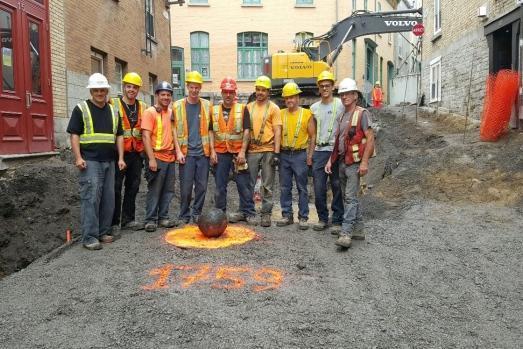Workers in Quebec pose with 90kg cannonball fired by British in 1759 - unaware it is still live
Army bomb disposal experts had to take it away to be neutralised or destroyed

Your support helps us to tell the story
From reproductive rights to climate change to Big Tech, The Independent is on the ground when the story is developing. Whether it's investigating the financials of Elon Musk's pro-Trump PAC or producing our latest documentary, 'The A Word', which shines a light on the American women fighting for reproductive rights, we know how important it is to parse out the facts from the messaging.
At such a critical moment in US history, we need reporters on the ground. Your donation allows us to keep sending journalists to speak to both sides of the story.
The Independent is trusted by Americans across the entire political spectrum. And unlike many other quality news outlets, we choose not to lock Americans out of our reporting and analysis with paywalls. We believe quality journalism should be available to everyone, paid for by those who can afford it.
Your support makes all the difference.Workers at a building site in Quebec posed next to a centuries-old cannonball without realising it was full of live gunpowder which would explode on impact.
The weapon, believed to have been fired by the British during a siege in 1759, was unearthed during excavation work.
It would have been designed to set fire to the building it landed against, with the powder igniting once the ball broke.
The workers took four photos with the 90kg (200lb) rusted ball.
They only realised the potential danger when archaeologist Serge Rouleau brought it home, CBC reports.
He found it still contained a live charge and gunpowder.
"With time, humidity got into its interior and reduced its potential for exploding, but there's still a danger," Master Warrant Officer Sylvain Trudel, a senior munitions technician. told CBC.
"Old munitions like this are hard to predict. You never know to what point the chemicals inside have degraded."
The cannonball is to be neutralised by Mr Trudel's team of army munitions technicians, who moved the cannonball to a safe site where it may have to be destroyed.
It is believed the cannonball was fired during the Battle of the Plains of Abraham, when the British besieged Quebec during the Seven Years’ War which helped end French rule.
British General James Wolfe and French commander Gen. Louis-Joseph, Marquis de Montcalm, died in the battle.
The cannonball will be stored in a museum for display if it does not have to be destroyed.
Join our commenting forum
Join thought-provoking conversations, follow other Independent readers and see their replies
Comments